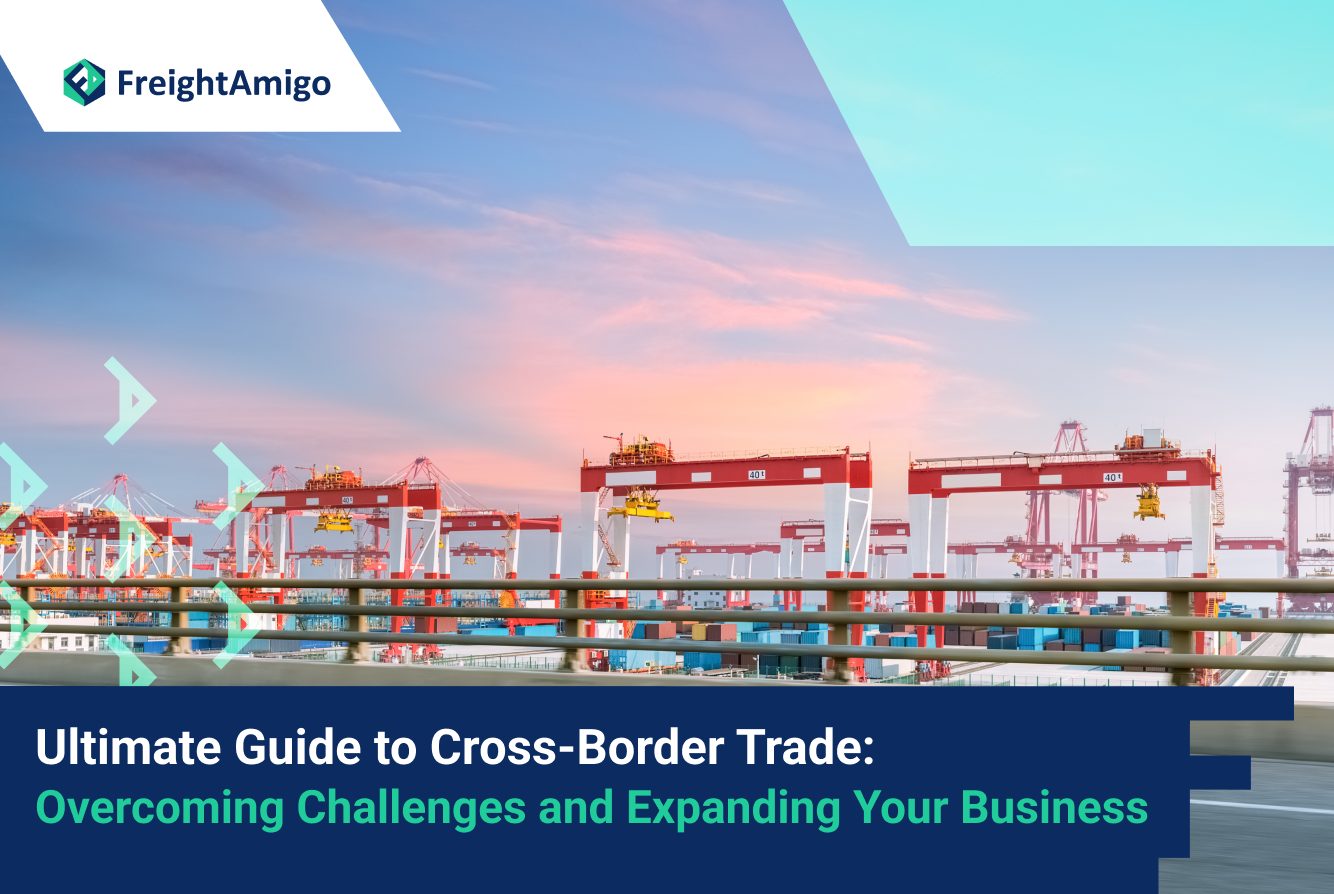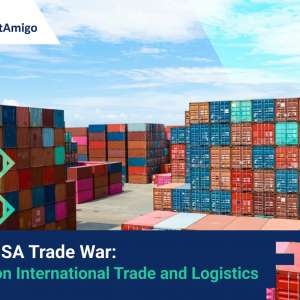Author Name: Tiffany Lee – Marketing Analyst at FreightAmigo
In today’s interconnected global economy, cross-border trade has become increasingly important for businesses looking to expand their reach and tap into new markets. However, engaging in international trade comes with its own set of challenges, from navigating complex tax regulations to dealing with language barriers and cultural differences. In this comprehensive guide, we will explore the key considerations and strategies for successful cross-border trade, helping you overcome the hurdles and unlock the potential for growth in your business.
Want To Compare The Best Express, Air Freight, Sea Freight, Rail Freight & Trucking Rates So As To Have Better Control On Cost?
Section 1: Understanding the Changing Landscape of Cross-Border Trade
The Impact of New VAT Rules
Trading within the European Union (EU), especially between the EU and Britain, has become more expensive due to the implementation of new VAT rules. Previously, no import VAT had to be paid for commercial goods valued up to €22. However, as of July 2021, VAT charges apply to all imports, regardless of cost. This change has added a financial burden for businesses involved in cross-border trade.
The Introduction of IOSS
To simplify the reporting and payment of VAT, the EU has introduced the Import One-Stop Shop (IOSS) system. While IOSS aims to streamline the process, it also comes with its own costs. Businesses are estimated to pay nearly £7,000 per year to register and comply with IOSS regulations. The implementation of IOSS requires a significant time investment and a steep learning curve, particularly for retailers who may feel overwhelmed by tax and compliance obligations.
Traditional Barriers to Cross-Border Trade
In addition to the new VAT rules and the introduction of IOSS, cross-border trade faces traditional barriers that businesses must navigate. Language barriers and a lack of knowledge about new marketplaces can pose challenges for companies looking to expand internationally. However, with the right resources and strategies, these obstacles can be overcome.
Section 2: Overcoming the Challenges of Cross-Border Trade
The Cost Factor
While the costs associated with cross-border trade may seem daunting, successful international trade can easily offset these expenses. Many businesses that have shied away from EU trade have noticed a significant decrease in annual revenue because they did not participate in OSS schemes. Effective financial management and exploring new marketplaces are key to managing costs and increasing sales.
Embracing Automation
Automation plays a crucial role in overcoming the challenges of cross-border trade. Implementing the right tax solutions can simplify complexities and reduce customs duties. Tools exist that can identify and generate the correct HS codes for products, minimizing customs duties. Automation can also help calculate customs duties, ensuring customers receive an accurate final landed price without any surprises upon delivery.
Leveraging Technology for Success
In the ever-evolving landscape of cross-border trade, staying ahead of ecommerce tax trends is essential. Engaging with the right technology solutions can make a significant difference in the success of your international trade endeavors. From data visualization capabilities to trade financing options, embracing technology can enhance efficiency, reduce risks, and support business expansion in the global market.
Section 3: Key Strategies for Successful Cross-Border Trade
Researching and Understanding Target Markets
Before venturing into cross-border trade, conducting thorough research and understanding the target markets is crucial. Gain insights into the local culture, consumer preferences, and market trends to tailor your products or services accordingly. This knowledge will help you position your business effectively and cater to the specific needs of your target audience.
Building Strong Partnerships
Collaborating with local partners in the target markets can provide invaluable support and insights. Establishing strong relationships with distributors, suppliers, or agents who have expertise in the local market can help navigate regulatory requirements, overcome language barriers, and build trust with local customers. These partnerships can also facilitate efficient logistics and ensure smooth operations.
Adapting to Cultural Differences
Cultural sensitivity is key when engaging in cross-border trade. Understanding and respecting cultural differences can help build trust and establish long-lasting relationships with customers. Tailor your marketing and communication strategies to reflect local customs, traditions, and language preferences. This personalized approach will resonate with customers and differentiate your business from competitors.
Streamlining Logistics and Supply Chain Management
Efficient logistics and supply chain management are essential for successful cross-border trade. Partnering with reliable freight forwarders, customs brokers, and logistics providers can streamline the movement of goods, ensure compliance with regulations, and reduce transit times. Embracing supply chain automation solutions, such as FreightAmigo, can further enhance efficiency and visibility across the entire supply chain.
Section 4: Navigating Tax and Compliance Obligations
Staying Compliant with VAT Regulations
Complying with VAT regulations is a critical aspect of cross-border trade. The implementation of IOSS simplifies the process by allowing businesses to provide a single VAT return instead of registering for VAT in every country they sell to. However, businesses must ensure they are correctly registered for IOSS and stay up-to-date with any changes in tax laws to avoid penalties or complications.
Seeking Professional Tax Advice
Tax law can be complex, especially when it comes to cross-border trade. Seeking professional tax advice can help businesses navigate the intricacies of international tax regulations and ensure compliance. Tax experts can provide guidance on VAT, customs duties, and other tax obligations, helping businesses make informed decisions and avoid costly mistakes.
Utilizing Trade Financing Options
Financing cross-border trade can be challenging, especially for small and medium-sized enterprises (SMEs). Exploring trade financing options, such as export financing, factoring, or letters of credit, can provide the necessary liquidity to support international transactions. These financing solutions can mitigate risks, improve cash flow, and enable businesses to seize new market opportunities.
Section 5: Expanding Your Business in the Global Market
Developing an International Expansion Strategy
Expanding your business in the global market requires a well-defined strategy. Identify target markets based on market research and develop a comprehensive plan that outlines the steps, resources, and timelines for entering new markets. Consider factors such as market size, competition, regulatory requirements, and cultural nuances when formulating your expansion strategy.
Ecommerce Platforms and Marketplaces
Ecommerce platforms and marketplaces offer a convenient way to reach global customers and expand your business internationally. Platforms like Amazon, eBay, and Alibaba provide access to a vast customer base and offer tools for managing cross-border transactions. Optimize your product listings, leverage localized marketing, and provide excellent customer service to maximize your success on these platforms.
Maintaining Flexibility and Agility
The global business landscape is constantly evolving, and it is essential to remain flexible and agile in your approach. Continuously monitor market trends, consumer behavior, and regulatory changes to adapt your strategies accordingly. Embrace innovation, stay ahead of the competition, and be prepared to pivot your business model when necessary.
Conclusion
Cross-border trade presents both challenges and opportunities for businesses. By understanding and navigating the complexities of international trade, leveraging automation and technology, and adopting the right strategies, you can overcome barriers and unlock the potential for growth in the global market. Stay informed, stay compliant, and stay agile to position your business for success in the exciting world of cross-border trade.
As a one-stop supply chain platform, FreightAmigo provides a variety of supply chain solutions for cross-border trade of enterprises. FreightAmigo seamlessly connects with cross-border trade by providing customs compliance support, efficient transportation solutions, trade financing options, and data visualization capabilities. At the same time, there is a HS automation program to help customers easily calculate and compare tax rates. This integration facilitates compliant and smooth international business operations, reduces risks, enhances efficiency, and supports business expansion in the global market. Contact us and let us give a cross-border trade solution for your business.
There Are Different Options For Cargo Transportation. If You Want To Choose The Most Convenient And Suitable Solution, It Is Best To Have The Full Support Of Logistics Experts! If You Are Planning To Ship Goods Overseas, Please Go To The FreightAmigo Page For Inquiries.
===
Read More:
【EU VAT Regulations】Reminders and Actions for Shippers
What is Green Logistics and its Strategy?
===
If you have any inquiries on logistics/supply chain, feel free to contact FreightAmigo now:
Chat with us online OR
Phone : +852 28121686
WhatsApp: +852 27467829



